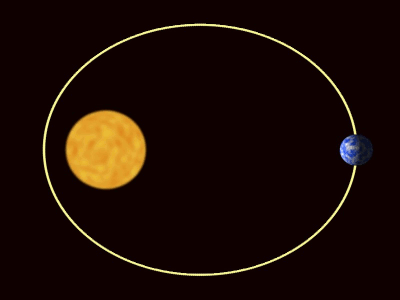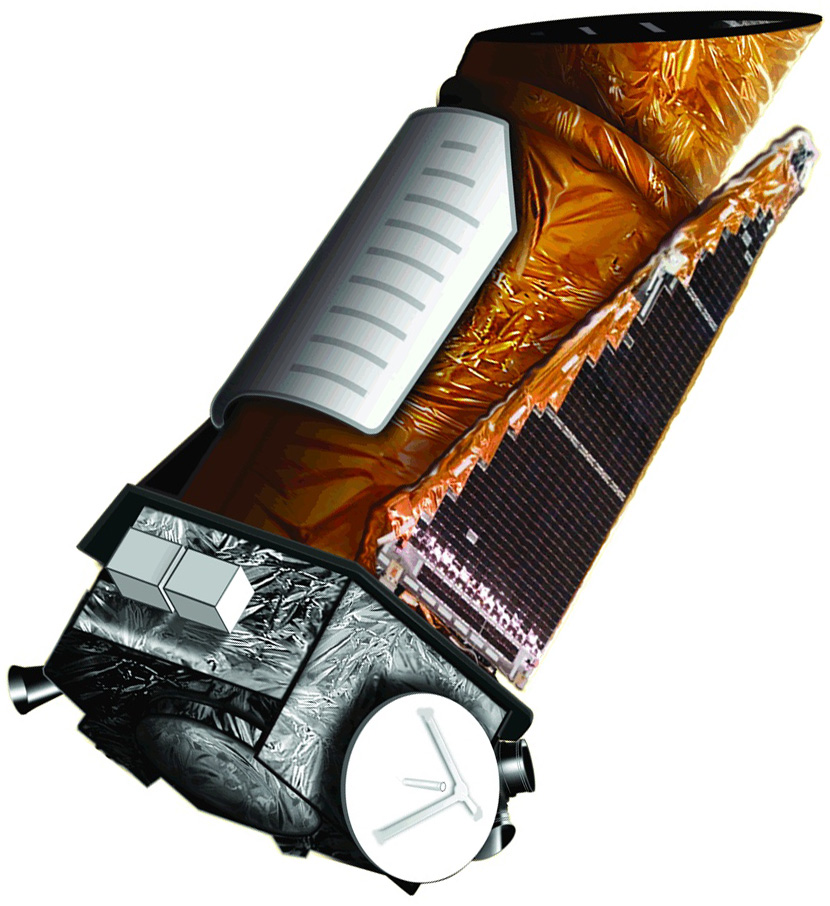
Strange Planets
“Strange Planets” is a fifty-minute planetarium program about finding extrasolar planets, focusing especially on the transit method & the Kepler Mission. It was originally designed for a sixth-grade audience. The primary goal of this planetarium show is for the audience to understand the difficulties of finding extrasolar planets, and to understand how those difficulties are overcome by modern astronomy techniques. The audience will consider interstellar distances and grapple with the two challenges of finding extrasolar planets—extrasolar planets are very far away, and are very dim compared to the stars they orbit. We discuss two ways it can be done: through the spectroscopic and the transit methods.
by Alice Enevoldsen, Alan Gould,
Toshi Komatsu, and Steven W. White
A collaboration of Pacific Science Center and the Lawrence Hall of Science
Contents
Preface
Objectives
Materials
Setup
Script
Discover More
Acknowledgements
Preface
This show, first announced in the March issue of The Planetarian in the article Share the Hunt for Other Earths, (A. Gould, T. Komatsu, E. DeVore, P. Harman, D. Koch). It is designed as live audience participation program, about 50-minutes long, but is modular, and as such can be adjusted for shorter lengths. Current version is presented at LHS for public audiences, best for ages 8-adult.
The show (50 min version) has the following sections:
- Introduction (5 min): Pose the context-setting questions: Are we alone? Do you think there might be other life out there? Hundreds of planets outside our solar system have already been discovered.
- Spectroscopic Method (10 min): Demo spectrum from a flashlight fitted with diffraction grating, then a star-planet demonstration/model of how gravity of an extrasolar planet causes a star to wobble, which in turn causes shifting spectral lines (the Doppler shift). How much a star wobbles depends on the mass of extrasolar planet(s) going around it and how fast a star wobbles is an indicator of how close it is to its star and hence how high its temperature is.
- Stars with Planets (5 min): Show two very easy-to-find stars with planets: Pollux (binary star in Gemini) and Alrai (orange star in Cepheus). Audience considers what it might be like to live on a “strange” planet, e.g. one with a binary star or an orange star.
- Kepler’s Laws and Habitable Zones (5 min): Audience learns that a habitable planet is one that has temperature and conditions for liquid water; that planet orbits are oval or elliptical in shape (Kepler’s 1st Law) and that how quickly a planet orbits its star depends on how close it is to its star, in accord with Kepler’s 2nd and 3rd Laws.
- Transiting Planets (10 min): Use a 2-planet orrery, light sensor and graphing software to demonstrate how brightness changes can be used in finding extrasolar planets–observing transits where a planet periodically blocks starlight, even though the planet is not visible. The audience sees the size of a planet is directly related to that amount of starlight it blocks and that how often starlight is blocked is related to how close a planet is to its star, thereby inferring the planet temperature and habitability.
- Finding an Earth-like Exoplanet (10 min): Audience studies simulated light curves to find pattern of an Earth-size in the habitable zone of its star.
- Kepler Star Field/Conclusion (5 min): Conclude with more specifics about the NASA Kepler Mission, including where in the sky its target regions of study is.
Strange Planets was field-tested at 5 planetariums and the final version revised based on field-test feedback.
Simple outline:
| 5 min | Introduction |
| 10 min | Spectroscopic Method |
| 5 min | Stars with Planets (Pollux, Alrai) |
| 5 min | Kepler’s Laws & Habitable Zones |
| 10 min | Transiting Planets |
| 10 min | Finding an Earth-like Exoplanet |
| 5 min | Kepler star field/Conclusion |
Objectives
Students will…
Introduction
- Know that hundreds of planets outside our solar system have been discovered.
- Know that planets outside the solar system are called extrasolar planets or exoplanets.
Spectroscopic Method
- Comprehend the core difficulty in finding extrasolar planets: they are too faint to see.
- Know that many planets have been found by observing spectra of starlight.
- Understand that gravity of an extrasolar planet can induce a star to wobble causing shifting spectral lines (the Doppler shift).
- Know that how much a star wobbles depends on the mass of extrasolar planet(s) going around it.
- Know that how fast a star wobbles is an indicator of how close it is to its star and hence how high its temperature is.
- Be shown that because closer, larger planets make their star wobble more they are easier to detect, so it is more likely to discover uninhabitable “Hot Jupiters.”
Stars with Planets
- Be shown the location of a bright star in the sky with a planet.
- Know that planets can be “strange”, e.g. have a binary star, or an orange star.
Kepler’s Laws and Habitable Zones
- Know that a habitable planet is one that has temperature and conditions for liquid water.
- Know that planet orbits are oval or elliptical in shape and that how quickly a planet orbits its star depends on how close it is to its star.
Transiting Planets
- Comprehend that a light meter can show brightness changes.
- Know that the transit method of finding extrasolar planets relies on the fact that a planet periodically blocks starlight, even though we can’t see the planet.
- Know that the size of planet is directly related to that amount of starlight it blocks.
- Know that how often starlight is blocked is related to how close a planet is to its star and hence the planet temperature and habitability.
- Know some things about NASA’s Kepler Mission.
Finding an Earth-like Exoplanet
- Analyze a light curve to make conclusions about an extrasolar planet’s size and distance from its star (and hence, temperature).
Materials
- Rainbow projector
- Portable star-planet model
- Orrery, Light Sensor, Graphing Software and Display for Light Curves
- Optional Handouts
Setup
- Set sky to a time when both Cygnus & Gemini are visible, e.g. May 25, 22:00, local time.
- Cue up images & videos.
- Rainbow maker ready (diffraction grating & flashlight)
- Spinning star-planet models ready. Set up orrery.
- Set up Vernier Light sensor, interface, laptop with graphing software, and video projector.
- Optional Handouts: Strange Planets take-home handout Side 1 and Side 2 and Exoplanet Size and Orbit Size Lookup Chart
DIGITAL EFFECT: Setup
Load all media for the program, including images and video clips. Set up the sky for the beginning of the program. Use December 1, 2011 as the start date, chosen because it is a time of year when Cygnus, Lyra, and Pegasus are all visible in the sky.
Planetarium Show Script
- Introduction: Strange Planets
- The Spectroscopic Method
- Stars With Planets
- Habitable Zones & Kepler’s Laws
- Transiting Planets
- Finding an Earth-like Exoplanet
- Conclusion: Strange Planets
Discover More About Exoplanets
California & Carnegie Planet Search – http://exoplanets.org/
The Extrasolar Planets Encyclopedia – http://exoplanet.eu/
Kepler Mission education website (archived)
Kepler Star Wheel
Tabletop Orreries (including LEGO® Orrery
PlanetQuest Website – http://planetquest.jpl.nasa.gov/
Wikipedia, the free encyclopedia— “Extrasolar Planet” Wikimedia Foundation – http://en.wikipedia.org/wiki/Extrasolar_planets
Top 10 Most Intriguing Extrasolar Planets
http://www.space.com/scienceastronomy/extrasolar_planets.html
The Kepler team displays the variations in brightness in a graph of brightness versus time, known as a light curve. One day, one of the Kepler scientists looked at the light curve of a star identified in the Kepler Input Catalog (KIC) as KIC12253350 and thought that a section of it looked like a heart. There was some moderate debate among some of the Kepler team as to what kind of variable star KIC12253350 must be, but no conclusive categorization has been agreed on. This T-shirt was produced for the January 2011 American Astronomical Society meeting in Seattle and for Valentine’s Day 2011. Another Kepler T-shirt has also been made (Got Planets?)
Acknowledgements
Production of Strange Planets was a joint effort of the Pacific Science Center planetarium (Alice Enevoldsen and Steve White) and the Lawrence Hall of Science Planetarium.
Funding for Strange Planets was provided by two sources:
- NASA Astrobiology Institute provided funds to Pacific Science Center for developing a version that was used for schools in the state of Washington.
- NASA Kepler mission provided funds to Lawrence Hall of Science to further develop the program and run both local pilot tests in the LHS Holt Planetarium as well as 70 planetariums nationwide. We are thankful to the Kepler Mission Principal Investigator, William Borucki, and Deputy PI, David Koch for their solid and consistent support for education and public outreach projects.
Thanks to Edna DeVore of SETI Institute for advice and for arranging for the funding of free planetarium show kits for the release of this program in the International Year of Astronomy (2009).
The following Lawrence Hall of Science staff ran the pilot tests in summers of 2008and 2009: Simona Balan, Malavika Lobo, Amelia Marshall, Margaret Nguyen, Katherine Koller, Alexandra Race, Sindhu Kubendran. Margaret Nguyen, Alexandra Race, and Sindhu Kubendran were actors for video sequences. Formative evaluation concepts were devised and implemented by Lawrence Hall of Science Research, Evaluation, and Assessment (REA) team member, Scott Randol as well as Dawn Robles of Inverness Research Associates. Sallie Lin of REA served as an observer for formative evaluation in the Lawrence Hall of Science pilot tests of 2008. Fiona Potter and Lucy Liu assisted in modeling the Walking Orrery that was added in 2011.
We are especially thankful to the following planetariums for field testing the show and providing feedback for the final version:
- Becky Lowder, Georgia Southern Planetarium, Statesboro GA
- Jack L. Northrup, Dr. Martin Luther King, Jr. Planetarium at King Science and Technology Magnet, Omaha NE
- Rod Martin, Brish Planetarium, Hagerstown MD
- Sheldon Shafer, Dave Grebner, Maegan Gilliland, Lakeview Museum of Arts & Sciences, Peoria IL

This material is based upon work supported by the National Science Foundation under Grant Number TPE-8751779. Any opinions, findings, and conclusions or recommendations expressed in this publication are those of the authors and do not necessarily reflect the views of the National Science Foundation.
Original edition: Copyright © 1990, by The Regents of the University of California. Revised editions: Copyright © 1993, 2003, 2009 by The Regents of the University of California. Planetarium Activities for Successful Shows and PASS are trademarks of The Regents of the University of California. Used with permission. All Rights Reserved. This work may not be reproduced by mechanical or electronic means without written permission from the Lawrence Hall of Science, except for pages to be used in classroom activities and teacher workshops. For permission to copy portions of this material for other purposes, please write to: Planetarium Director, Lawrence Hall of Science, University of California, Berkeley, CA 94720.
The original edition printing of the Planetarium Activities for Successful Shows series was made possible by a grant from Learning Technologies, Inc., manufacturers of the STARLAB Portable Planetarium.

